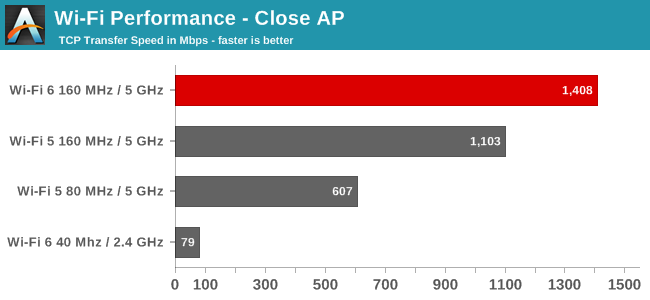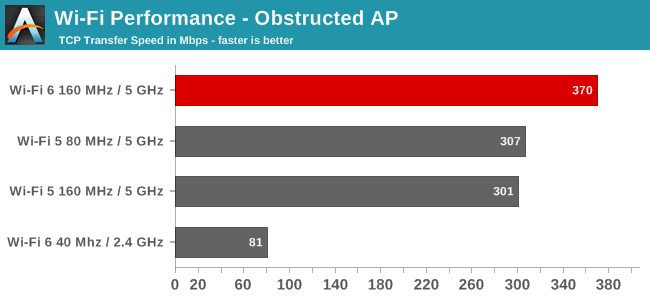AT 101: Wi-Fi 6 And Why You Want It
by Brett Howse on February 12, 2020 8:00 AM ESTPerformance
In order to achieve maximum performance, the latest Wi-Fi 6 standard leverages 1024-level QAM, but depending on the signal strength and quality it will scale down as needed, so to achieve the best performance very high signal to noise ratios are going to be required. Since 5 GHz is attenuated dramatically when it has to go through walls, if you need maximum Wi-Fi performance be aware that you are going to want your wireless router as close to the end device as possible. Luckily that is not an issue in our case, since the router is in the same room when testing for maximum performance, but we’ll also evaluate it in less than ideal scenarios as well.
Wi-Fi 5 vs Wi-Fi 6 – Close AP
First up we’ll test the TCP performance when the Access Point is in the same room as the client.

The performance advantages of Wi-Fi 6 are clear. With the access point in the same room, the SNR is very good and the new 802.11ax standard can really shine. With 1024 QAM and 160 MHz channels, the performance is over twice as fast as the outgoing Wi-Fi 5 with 256 QAM and 80 MHz channels. It is very impressive to see a typical 2x2:2 connection well over the Gigabit barrier, and even though the AX200 network card is the first generation, Intel has already done a fantastic job tuning it. The theoretical maximum transfer rate with 160 MHz channels and 1024 QAM is around 1200 Mbps per connection, so a 2x2 can in theory hit around 2.4 Gbps, meaning there's still room for improvement. Since 802.11ax also can be used on the 2.4 GHz frequency, unlike 802.11ac, the same test was also done on 2.4 GHz, and the results were disappointing. 2.4 GHz can still offer 40 MHz channels, but it doesn’t seem like the AX200 could take advantage of any of that. For reference, the wireless adapter in the laptop was reporting -21 dBm, which is a strong signal, which makes sense since the AP is almost right next to the laptop.
Wi-Fi 5 vs Wi-Fi 6 – Reduced Signal
Moving the laptop further away, and adding several walls and doors in the way to attenuate the signal, the same scenarios were again tested.

With some walls in the way, 5 GHz gets attenuated quite dramatically, and the SNR in the second location was -78 dBm. With such a low signal, the Wi-Fi 6 connection wasn’t able to take advantage of the 1024-level QAM and would have had to drop down to a much lower set, reducing the number of bits per tone, and even though the total channel bandwidth was still 160 MHz, it was only marginally faster on 802.11ax than 802.11ac 80 MHz. 2.4 GHz is not as impacted by walls, and as such was able to maintain the same transfer rate, even though it was still quite a bit slower.
So the results are clear. Wi-Fi 6 can offer a significantly higher level of throughput than Wi-Fi 5, but in order to do so, it needs a strong signal. The Wi-Fi 6 still outperformed the Wi-Fi 5 in the second test with an attenuated signal, but the performance gain was minimal. 2.4 GHz still offers the best signal strength, and therefore would be able to connect further away, and through more obstacles, but doesn’t offer anywhere near the performance of the 5 GHz range. It will be interesting to see the Wi-Fi 6E devices with 6 GHz support when they launch. It will open up Wi-Fi to a wider set of frequency choices, but will offer even less range.










149 Comments
View All Comments
levizx - Wednesday, February 12, 2020 - link
Because affordable 1Gbps connection isn't a thing for even 90% of high-end buyers yet, let alone > 1GbpsMakaveli - Wednesday, February 12, 2020 - link
If you are in the US then yes internet is terrible in america.Fortunately for me I live in Canada and on a 1Gbps Fiber connection.
triphoppingman - Wednesday, February 12, 2020 - link
This article from 2016 actually says Canadia is barely faster than Mexico.https://www.forbes.com/sites/kevinmurnane/2016/09/...
Wikipedia agrees:
https://en.wikipedia.org/wiki/List_of_countries_by...
Makaveli - Wednesday, February 12, 2020 - link
lol you believe a Wiki Article then.Unless you live in chattanooga or have access to AT&T fiber or google fiber or fios you are pretty much stuck with Cable/dsl for options which are data capped.
Most of our major ISP's in Canada got rid of data caps years ago.
Trust me when I tell you Canadian internet is generally better than what you can get in the US.
imaheadcase - Wednesday, February 12, 2020 - link
Thats pretty subjective though considering Canada population is mostly in one area vs the US.Makaveli - Wednesday, February 12, 2020 - link
Subjective or not its the truth.not trying to get in a population density argument like the Europeans that come in trying to do the same thing lol.
nathanddrews - Wednesday, February 12, 2020 - link
That's the problem with relying on aggregated national data rather than per-market pricing. I can get 1Gbps fiber for $130/mo in my suburb, but 10 miles north of me the only option is dial-up (cheap/slow) or satellite (expensive/slow). 10 miles west of me, there's a smaller fiber ISP offering 2.5Gbps for $150/mo that I can't get. It's not rocket science, just infrastructure and economics.Flipper34 - Wednesday, February 12, 2020 - link
Even out here in the rural midwest we have fiber to the home available. It isn't inexpensive for the higher speeds, but it is available. Our connection was upgraded to fiber at no cost, but we are on a low speed cheap plan! :)Ratman6161 - Wednesday, February 12, 2020 - link
where in the midwest are you? That is certainly not true in Minnesota. I'm about 40 miles from Minneapolis and 200 Mbps is the best I can get. For family about 10 miles out of St Cloud, 40 is the best they can get. further out it goes down from there. Likewise with cellular. the carriers are hyping 5g when there are vast areas in the northern half of MN and WI that cant even get reliable 4G and when the can its only one carrier to choose from.pjcamp - Wednesday, February 12, 2020 - link
For anything not controversial, Wikipedia articles are pretty accurate. I'm a physicist and I'm thoroughly impressed by the physics articles.